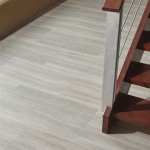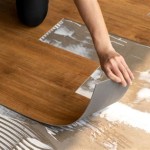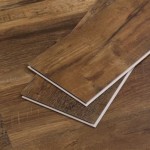Home Flooring: A Guide to Choosing the Right Material
Choosing the right flooring for your home is an important decision that can significantly impact the overall aesthetics, functionality, and longevity of your living space. With a wide array of materials available, it can be overwhelming to navigate the options and select the best fit for your needs. This article will provide a comprehensive overview of various home flooring materials, outlining their characteristics, pros, and cons to help you make an informed decision.
Hardwood Flooring
Hardwood flooring has long been a popular choice for homes, renowned for its timeless elegance and durability. It is typically made from solid wood planks that are sanded, stained, and finished to create a beautiful and natural look. Hardwood floors are available in a wide range of species, each with its unique grain patterns, colors, and hardness ratings.
Some of the advantages of hardwood flooring include:
- Durability: Hardwood is known for its strength and resilience, able to withstand heavy foot traffic and furniture placement.
- Beauty: The natural wood grain and warm tones of hardwood create a classic and sophisticated look.
- Versatility: Hardwood can be sanded and refinished multiple times, allowing you to change the color and style of your floors over time.
- Value: Hardwood floors are a good investment, as they can increase the resale value of your home.
However, hardwood flooring also has some drawbacks:
- Cost: Hardwood floors can be expensive, especially for higher-quality species and installation costs.
- Maintenance: Hardwood requires regular cleaning and occasional refinishing to maintain its beauty and longevity.
- Susceptibility to damage: Hardwood can be susceptible to scratches, dents, and water damage.
Tile Flooring
Tile flooring is a versatile and durable option that is suitable for various areas of the home, including kitchens, bathrooms, and entryways. Tiles are made from various materials, such as ceramic, porcelain, natural stone, and even glass, offering a wide range of colors, patterns, and textures to suit different styles.
Tile flooring offers several advantages, including:
- Durability: Tile is highly resistant to scratches, dents, and stains, making it an excellent choice for high-traffic areas.
- Water resistance: Tile is impervious to water, making it ideal for bathrooms, kitchens, and other areas prone to moisture.
- Easy maintenance: Tile flooring is generally easy to clean, requiring only a simple sweep or mop.
- Variety: Tile offers a vast selection of styles, colors, and textures to match any design aesthetic.
However, tile flooring also has some drawbacks to consider:
- Coldness: Tile can feel cold underfoot, especially in colder climates.
- Hardness: The hard surface of tile can be uncomfortable to stand on for extended periods.
- Installation: Tile installation can be more complex and labor-intensive compared to other flooring types.
Laminate Flooring
Laminate flooring is a popular choice for homeowners seeking the look of hardwood at a more affordable price. It consists of multiple layers, including a wear layer that simulates the appearance of wood, stone, or tile. Laminate flooring is available in various styles, colors, and textures, offering a wide range of options for different design aesthetics.
Laminate flooring offers several advantages, including:
- Affordability: Laminate flooring is typically more affordable than hardwood or tile flooring.
- Durability: Laminate flooring is resistant to scratches, dents, and stains, making it suitable for high-traffic areas.
- Easy installation: Laminate flooring is typically easy to install, often using a click-lock system.
- Water resistance: Some laminate flooring options are water-resistant, making them suitable for bathrooms and kitchens.
However, laminate flooring also has some drawbacks:
- Synthetic appearance: Laminate flooring can sometimes have a synthetic feel and appearance compared to natural materials.
- Limited refinishing: Unlike hardwood, laminate flooring cannot be sanded and refinished.
- Potential for moisture damage: While some laminate floors are water-resistant, they are not fully waterproof and can be damaged by prolonged exposure to moisture.
Carpet Flooring
Carpet flooring remains a popular choice for many homeowners, providing warmth, comfort, and sound absorption. It is available in a wide range of fibers, textures, and colors, offering a diverse selection to suit different styles and budgets.
Carpet flooring offers several advantages, including:
- Comfort: Carpet provides a soft and comfortable surface to walk on, adding warmth and insulation to your home.
- Sound absorption: Carpet helps reduce noise levels, making your home more peaceful and quiet.
- Variety: Carpet is available in a wide range of colors, textures, and patterns to match any design style.
- Affordability: Carpet flooring can be a budget-friendly option, especially for large areas.
However, carpet flooring also has some drawbacks:
- Maintenance: Carpet requires regular cleaning and vacuuming to maintain its appearance and hygiene.
- Allergens: Carpet can trap dust, pollen, and other allergens, making it a potential issue for allergy sufferers.
- Staining: Carpet can be prone to stains, requiring prompt cleaning and care.
- Durability: Carpet can be susceptible to wear and tear, especially in high-traffic areas.
Vinyl Flooring
Vinyl flooring is a popular choice for homeowners seeking a durable and affordable flooring option. It is made from synthetic materials that mimic the appearance of various materials, including wood, stone, and tile. Vinyl flooring is available in various styles and colors, offering a wide range of design options.
Vinyl flooring offers several advantages, including:
- Durability: Vinyl flooring is resistant to scratches, dents, and stains, making it suitable for high-traffic areas.
- Water resistance: Vinyl flooring is waterproof, making it an excellent choice for bathrooms, kitchens, and other areas prone to moisture.
- Easy maintenance: Vinyl flooring is easy to clean, typically requiring only a simple sweep or mop.
- Affordability: Vinyl flooring is typically more affordable than hardwood or tile flooring.
However, vinyl flooring also has some drawbacks:
- Synthetic appearance: Vinyl flooring can sometimes have a synthetic feel and appearance compared to natural materials.
- Limited refinishing: Unlike hardwood, vinyl flooring cannot be sanded and refinished.
- Potential for fading: Vinyl flooring can fade over time, especially when exposed to direct sunlight.
Ultimately, choosing the right flooring for your home depends on your specific needs, budget, and design preferences. Consider carefully the pros and cons of each material and weigh them against your priorities to make an informed decision. When in doubt, consulting with a flooring specialist can provide valuable advice and guidance.

Home Decorators Collection Larkmead Oak 12 Mm T X 7 6 In W Waterproof Laminate Wood Flooring 16 Sqft Case 56810 The Depot

Flooring Materials To Consider Forbes Home

Flooring The Home Depot

The Best Flooring Options For A Contemporary Home Hq Longwood Fl

Modern Flooring Ideas 11 Options For Contemporary Homes Inc

Whole House Flooring Ideas Carpet One Floor Home

The Best Flooring For Re Inc

Appalachian Trail Fine Oak Luxury Vinyl Plank

Selecting The Right Flooring For Your New Home

Upgrading Your Floors The Pros And Cons Of 5 Popular Flooring Choices
Related Posts








